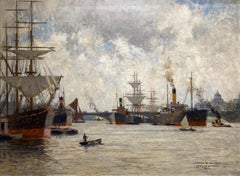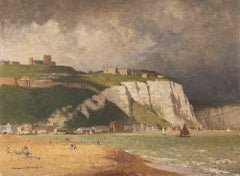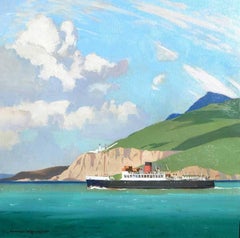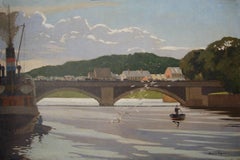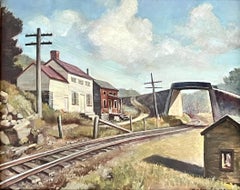Norman Wilkinson CBE PRI Paintings
British, 1878-1971
Born in Cambridge in 1898 and educated at Southsea School of Art, Norman Wilkinson is known for his graphic art, specifically his British Railway poster images, and also for something quite incredible; Wilkinson revolutionized the art of naval camouflage. Having been assigned to submarine patrols in Dardanelles, Gallipoli, and Gibraltar during WWI as a member of the Royal Navy Volunteer Reserve, Wilkinson was deeply troubled by the unprecedented success the German submarine fleet had torpedoing British ships. He hoped to find a solution to this gaping vulnerability, and in a lightning bolt moment, he had an epiphany that would change everything. Wilkinson says in his autobiography, A Brush With Life (Seeley, 1969), that he realized a ship could be painted to hide its shape against the sea and sky. In his own words, Wilkinson states that the hull of a ship could be camouflaged "not for low visibility, but in such a way as to break up her form and thus confuse a submarine officer as to the course on which she was heading." After some preliminary testing, the theory Wilkinson called "dazzle camouflage" was accepted by British Admiralty and Wilkinson was placed in charge of the naval camouflage unit. The unit, which was headquartered in the basement of the Royal Academy of Arts, consisted of Wilkinson and about two dozen "camoufleurs;" they were artists, students, model makers and consultants, including a zoologist. The dazzle schemes were tested on models and then distributed to artists who were stationed at the docks, where the ships would be painted. At the end of the war Wilkinson was formally declared the inventor of dazzle camouflage and awarded for his contribution.
Wilkinson went on to enjoy a long and celebrated career as a painter of maritime scenes, naval vessels, and warships. He served as the president of the Royal Institute of Painter in Water Colours (RI) from 1936 until 1963 (elected member in 1906); he was elected Honourable Marine Painter to the Royal Yacht Squadron in 1919, and he was a member of the Royal Society of British Artists, the Royal Institute of Oil Painters, the Royal Society of Marine Artists, and the Royal Scottish Society of Painters in Watercolour. In 1918 he was appointed an Officer of the Order of the British Empire (OBE), and a Commander of the Order (CBE) in 1948. In January 1920 he was appointed knight (chevalier) of the Belgian Order of the Crown.
Among many notable points of interest regarding Wilkinson's career is that his painting Plymouth Harbour, which was commissioned by Cunard White Star Lines for the first class smoking room of the RMS Titanic, was lost at sea when it perished with the ship. Wilkinson had also created a comparable painting entitled The Approach to the New World, for the Titanic's sister ship, the RMS Olympic. This work may be seen in the 1958 film A Night to Remember in scenes aboard the Titanic, where is served as the stand-in for Plymouth Harbor.(Biography provided by Rob Zanger Rare Books LLC)
to
7
5
6
1
1
1
1
1
3
Overall Height
to
Overall Width
to
2
1
3
3
3
2
2
2
1
1
1
1
1
1
1
1
1
1
1
1
1
1
7
1
15
834
655
649
610
7
6
2
1
1
Artist: Norman Wilkinson CBE PRI
The Pool of London
By Norman Wilkinson
Located in London, GB
Signed and dated '1902' lower right
Contemporary style hand made frame
Provenance:
Tryon Gallery
Private collection
In this painting we can we Blackfriars Bridge in the background reaching across the River Thames with smoke billowing up into the sky behind. On the far right the unmistakable, and instantly recognisable, silhouette of St Pauls also breaks the sky line of the city. Finished in the early 18th Century, St Pauls has been a noticeable addition to the London cityscape ever since.
This work by Wilkinson depicts 'The Pool' of London, a stretch of the River Thames from London Bridge to below Limehouse. As part of the Tideway of the Thames, the Pool was navigable by tall-masted vessels bringing coastal and oversea goods to the wharves that originally made up the Port of London. In 1909 the Pool came under the jurisdiction of the Port of London Authority. The docks here thrived until the late 1950s, despite suffering from extreme bomb damage during the Second World War.
The tall-masted ships that Wilkinson has depicted here are perfect examples of traditionally rigged sailing craft of the time. They differ from modern sailing vessels in that they did not use newer materials (such as aluminium and steel) and have more complex rigging as a result. The term tall ship later came into widespread use in the mid-20th century with the advent of Tall Ships' races. Here, incredible attention to detail has been applied by Wilkinson in the accurate depiction of the various ships rigging...
Category
20th Century English School Norman Wilkinson CBE PRI Paintings
Materials
Oil
The Foreshore - Dover, 20th Century Oil Landscape
By Norman Wilkinson
Located in London, GB
Norman Wilkinson
1878 - 1971
The Foreshore - Dover
Oil on canvas, signed lower left and dated 1959 on verso
Image size: 24½ x 38¾ inches
Art Deco frame
Proven...
Category
1950s Norman Wilkinson CBE PRI Paintings
Materials
Oil
The Isle of Skye Ferry, 20th Century Travel Poster Original Oil
By Norman Wilkinson
Located in London, GB
Norman Wilkinson CBE PRI
1878 - 1971
The Isle of Skye Ferry
Oil on board on canvas
Signed lower left
Image Size: 20.75 x 20.75 inches
Norman Wilkinson was a British artist in oil, watercolour and dry point, usually of marine subjects. An illustrator and poster artist, he also made an important contribution in both World Wars in the field of camouflage, namely dazzle camouflage.
Educated at Berkhamsted School and St Paul's Cathedral choir school, he had little training in art but largely developed his style through his maritime career.
In 1898 he started contributing to The Illustrated London News and The Illustrated Mail which was the start of a long association. In Paris in 1899 he studied figure painting but was already set upon working on marines. With his love of the sea he travelled extensively including visits to Spain, Germany, Italy, Malta, Greece, Aden, Bahamas, United States, Canada, and Brazil. He was elected R.I. in 1906.
During World War I he served at the Dardanelles, on submarine patrol in the Mediterranean, and on a minesweeper in the English Channel. One of his paintings was on the Titanic when it sank.
During World War I, while serving in the Royal Naval Volunteer Reserve, he was assigned to submarine patrols in the Dardanelles, Gallipoli and Gibraltar, and, beginning in 1917, to a minesweeping operation at HMNB Devonport.
In April 1917, German submarines (called U-boats) achieved unprecedented success in torpedo attacks on British ships, sinking nearly eight per day. In his autobiography, Wilkinson remembers the moment when, in a flash of insight, he arrived at what he thought would be a way to respond to the submarine threat (Wilkinson 1969, p. 79).
He decided that, since it was all but impossible to hide a ship on the ocean (if nothing else, the smoke from its smokestacks would give it away), a far more productive question would be: How can a ship be made to be more difficult to aim at from a distance through a periscope? In his own words, he decided that a ship should be painted "not for low visibility, but in such a way as to break up her form and thus confuse a submarine officer as to the course on which she was heading" (Wilkinson 1969, p. 79).
After initial testing, Wilkinson's plan was adopted by the British Admiralty, and he was placed in charge of a naval camouflage unit, housed in basement studios at the Royal Academy of Arts. There, he and about two dozen associate artists and art students (camoufleurs, model makers, and construction plan preparators) devised dazzle camouflage schemes, applied them to miniature models, tested the models (using experienced sea observers), and prepared construction diagrams that were used by other artists at the docks (one of whom was Vorticist artist Edward Wadsworth) in painting the actual ships. In early 1918 Wilkinson was assigned to Washington, D.C. for a month, where he served as a consultant to the U.S. Navy, in connection with its establishment of a comparable unit (headed by Harold Van Buskirk, Everett Warner, and Loyd A. Jones)(Hartcup 1980; Behrens 2002, 2009; Wilkinson 1969).
After World War I, there was some contention about who had originated dazzle painting. When Wilkinson applied for credit to the Royal Commission on Awards to Inventors, he was challenged by several others. At the end of a legal procedure, he was formally declared the inventor and awarded monetary compensation (Wilkinson 1969, pp. 94–95).
As a poster designer, Wilkinson reached his highest artistic level. His posters were well-planned and executed in broad tones of colour with a skilful use of black to strengthen the design. He made his first poster (of the Irish steamer crossing from Holyhead to Dublin) in 1905. It was the first to illustrate the product as just one element of a broader landscape and its revolutionary design was a major influence in the development of the pictorial poster. Wilkinson went on to organise the celebrated commissioning of poster designs from members of the Royal Academy for the London Midland and Scottish Railway company in the 1920s. Through the dissemination of his posters to railway stations, schools, and government offices throughout the world, he became one of the most familiar artists in the British Empire.
He was elected Hon. Marine Painter to the Royal Yacht Squadron in 1919, P.R.I. in 1937. He was knighted in 1948 and appointed a CBE in 1948. Wilkinson created a painting titled "The Approach to Plymouth Harbour" for the smoking room of the RMS Titanic, which sank with the ship. Wilkinson is one of the finest marine painters of this century.
Prolific and long-lived, Norman Wilkinson led an active and adventurous life until his death in 1971. A regular exhibitor at the Royal Academy, he was president of the Royal Institute of Painters in Watercolours and a member of the Royal Institute of Oil Painters. His work can be found in many public and private collections listed below. He painted a record of the major sea battles of the Second World War and presented the series of 54 paintings to the nation; they are kept at the National Maritime Museum.
Produced his first poster in 1905! He brought the simplicity and truth to poster design. Nothing like it had been seen before. He said he was the “Father & Mother” of the artistic poster on English railway stations. He persuaded 17 Royal Academy artists to design posters. He raised the status of the poster painter and the quality of the art poster. A contemporary of William Frith...
Category
20th Century Norman Wilkinson CBE PRI Paintings
Materials
Board, Oil
RHUDDLAN CASTLE, 20th Century Art-Deco (Artwork for Travel Poster)
By Norman Wilkinson
Located in London, GB
Norman Wilkinson CBE PRI
1878 – 1971
RHUDDLAN CASTLE
Oil on canvas, signed lower right
Image size: 30 x 45 inches (76 x 114 cm)
Hand made frame
Provenance
Commissioned by London, Mi...
Category
Early 20th Century Art Deco Norman Wilkinson CBE PRI Paintings
Materials
Oil
HARROW SCHOOL, Art-Deco 20th Century Signed Oil and Gouache
By Norman Wilkinson
Located in London, GB
Norman Wilkinson CBE PRI
1878 – 1971
HARROW SCHOOL
Oil and gouache on paper, signed lower right
Image size: 30 × 45 inches (76 × 114 cm)
Original frame
Provenance
Commissioned by L...
Category
20th Century Art Deco Norman Wilkinson CBE PRI Paintings
Materials
Oil, Paper, Gouache
THE BANN AT COLERAINE, Mid 20th Century Oil (Commissioned by British Railways)
By Norman Wilkinson
Located in London, GB
Norman Wilkinson CBE PRI
1878 – 1971
THE BANN AT COLERAINE
Oil on canvas, signed lower right
Image size: 30 x 44 ½ inches (76 x 113 cm)
Provenance
Commissioned by British Railways 1...
Category
Mid-20th Century Norman Wilkinson CBE PRI Paintings
Materials
Oil
A pair of FINE original Watercolours of ENGLISH & SCOTTISH fishing rivers SIGNED
By Norman Wilkinson
Located in Cirencester, GB
ARTIST: Norman Wilkinson CBE RI (1878-1971) English
TITLE: "The Cauld River Tweed Scotland" & "the River Avon Ibsely Hampshire" (A PAIR)
SIGNED: lower right and lower left
MEDIUM: w...
Category
Mid-20th Century Post-Impressionist Norman Wilkinson CBE PRI Paintings
Materials
Watercolor
Related Items
Evening prayers by fishermen under the high coast of Celebes
Located in Amsterdam, NL
Jacob Eduard Van Heemskerck Van Beest (1828-1894)
“Avondgebed; Maleidische tripang visschers onder de hoge kust van Celebes” (Ev...
Category
19th Century Romantic Norman Wilkinson CBE PRI Paintings
Materials
Canvas, Oil
Free Shipping
H 26.38 in W 42.13 in D 1.58 in
Untitled (Houses and Railroad Tracks)
By Harry Lane
Located in Los Angeles, CA
Untitled (Houses and Railroad Tracks), c. 1940s, oil on canvas board, signed lower right, 16 x 20 inches, presented in a newer frame
This work is part of our exhibition America Coas...
Category
1940s American Modern Norman Wilkinson CBE PRI Paintings
Materials
Oil, Board
John White, The Big One, Oil Painting
By John White
Located in Cheltenham, GB
This late 19th-century oil painting by Scottish artist John White (1851-1933) depicts a boy fishing in a stream with the sea beyond.
With his line taut, he leans back and looks opti...
Category
1880s English School Norman Wilkinson CBE PRI Paintings
Materials
Canvas, Oil
Duet #3, Large Art Deco Painting by Erik Freyman
By Erik Freyman
Located in Long Island City, NY
"Duet #3" is an original painting on canvas measuring 48 x 36 inches by Erik Freyman. The artist is best known for his 80's style which draws heavily on Art Deco and Cubism.
Frey...
Category
1980s Art Deco Norman Wilkinson CBE PRI Paintings
Materials
Acrylic, Canvas
Ammonite
Located in Knowle Lane, Cranleigh
Ammonite is a semi-abstract landscape painted in oil onto canvas by Dion Salvador Lloyd, a contemporary artist renowned for his profound sensitivity and profound connection to the na...
Category
2010s Contemporary Norman Wilkinson CBE PRI Paintings
Materials
Oil
Louis PASTOUR (1876-1948) French Post Impressionist 1928 Art Deco Period
Located in Holywell, GB
Louis PASTOUR (1876-1948)
Cannes 1928
A delightful painting of a coastal landscape depicting fishing boats and figures on a beach near Cannes by the French post impressionist artis...
Category
1920s Art Deco Norman Wilkinson CBE PRI Paintings
Materials
Oil
Free Shipping
H 17 in W 22.5 in D 1 in
Sailboats and Sailing Ship in Seascape early 20th Century Oil Painting Framed
Located in Stockholm, SE
This artwork showcases the beauty of sailing boats and ships sailing gracefully on the sea waters. The artist's attention to detail is evident in the intricate depiction of the ships...
Category
Early 20th Century Realist Norman Wilkinson CBE PRI Paintings
Materials
Wood, Oil, Cardboard
Venice Landscape Italian Oil on Canvas Painting in Gilt Wood Frame, Belle Epoque
Located in Firenze, IT
This delightful turn of the century (early 20th century) oil on canvas painting represents an Italian landscape with one of the most famous squares in the world: Piazza San Marco in ...
Category
Early 20th Century Impressionist Norman Wilkinson CBE PRI Paintings
Materials
Canvas, Oil
Venice Landscape Italian Oil on Canvas Painting in Gilt Wood Frame, Belle Epoque, Early 20th Century
H 51.19 in W 33.47 in D 1.19 in
Before Storm Vivid Landscape by Swedish Master 19th century
Located in Stockholm, SE
Attributed by Wilhelm von Gegerfelt (1844—1920). The disheveled crowns of the trees indicate to us the raging wind, and the evening sky in the background...
Category
Late 19th Century Impressionist Norman Wilkinson CBE PRI Paintings
Materials
Wood, Oil, Cardboard
Emmanuel Aubain (1872-1965) A Landscape, signed oil painting
Located in Paris, FR
Emmanuel Aubain (1872-1965)
A Landscape
Signed lower left
Oil on canvas transefered on cardboard panel
In quite good condition, some abrasions in the r...
Category
1930s Art Deco Norman Wilkinson CBE PRI Paintings
Materials
Oil
Couple by Farmyard oil painting by Martha Cahoon
By Martha Cahoon
Located in Hudson, NY
Signed "Martha Cahoon" lower right.
Provenance: private collection, Palm Beach Florida
About this artist: Born of Swedish immigrant parents in 1905, in Rosindale, Massachusetts, Martha Farham Cahoon had a highly successful business partnership with her husband Ralph Cahoon...
Category
1960s Folk Art Norman Wilkinson CBE PRI Paintings
Materials
Oil, Board
My Only Working Tool
Located in Los Angeles, CA
My Only Working Tool, 1949, oil on panel, signed and dated lower right, 16 x 12 inches, remnant of exhibition label verso, exhibited at the Art News Second Annual National Amateur Co...
Category
1940s American Modern Norman Wilkinson CBE PRI Paintings
Materials
Oil, Board
Norman Wilkinson Cbe Pri paintings for sale on 1stDibs.
Find a wide variety of authentic Norman Wilkinson CBE PRI paintings available for sale on 1stDibs. If you’re browsing the collection of paintings to introduce a pop of color in a neutral corner of your living room or bedroom, you can find work that includes elements of blue and other colors. You can also browse by medium to find art by Norman Wilkinson CBE PRI in oil paint, paint, board and more. Much of the original work by this artist or collective was created during the 20th century and is mostly associated with the Art Deco style. Not every interior allows for large Norman Wilkinson CBE PRI paintings, so small editions measuring 23 inches across are available. Customers who are interested in this artist might also find the work of Bela Kadar, Jaro Fabry, and Francis Plummer. Norman Wilkinson CBE PRI paintings prices can differ depending upon medium, time period and other attributes. On 1stDibs, the price for these items starts at $12,909 and tops out at $35,276, while the average work can sell for $30,675.
